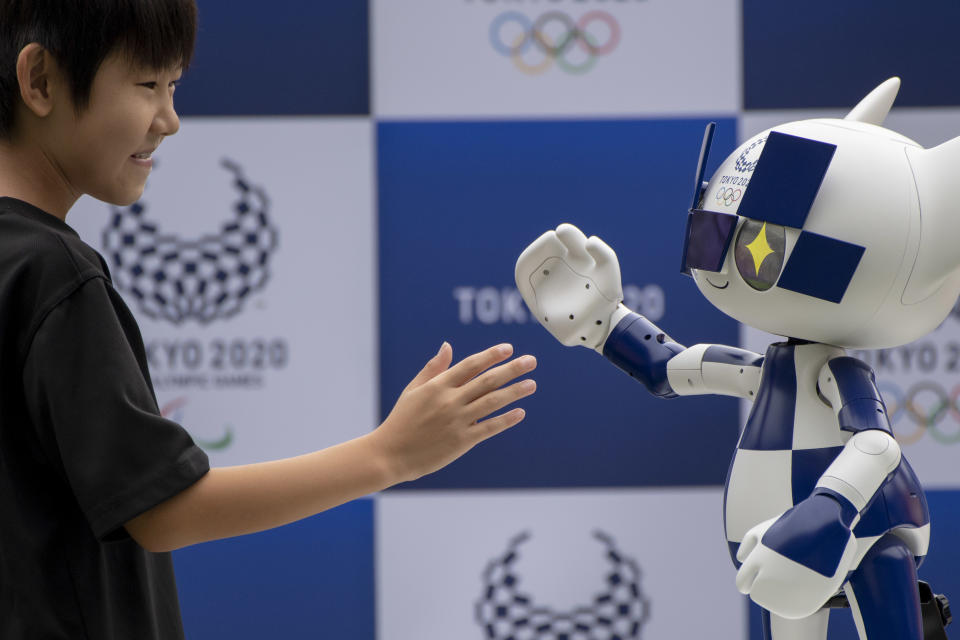Tokyo 2020: Robots will do everything short of competing for medals

If you’ve ever wanted to watch a robot high-five Simone Biles after she dismounts, the 2020 Tokyo Olympic Games has that possibility covered.
Organizers in Japan are tasked with going beyond the legacy set at the 1964 Tokyo Games when it ushered in the innovative technology of timing devices that clocked hundredths of a second and the first satellite broadcasts of the Olympics.
Now they’ll introduce robotic technology. Tokyo 2020 will feature five types of robots, including the Olympics’ first Delivery Support Robot (DSR) and its first robot to retrieve equipment at track and field’s throwing events. All are designed by Japanese manufacturer Toyota and will be used to greet spectators, create virtual reality and fetch athletes’ equipment.
Following in the path of the 2018 PyeongChang Winter Olympics, there will be robots in the likeness of the official mascots, Miraitowa and Someity. The mascot robots, which feature responsive expressions with big blue and pink eyes, will be greeters and available for photo ops, per Tech Crunch.
Once spectators get inside, the Human Support Robot (HSR) will guide guests to their seats and help get small, light refreshments. These robots are intended to help spectators in wheelchairs “enjoy the games without worrying about their mobility,” Minoru Yamauchi, Toyota’s general manager for 2020 Robot Development, told the Associated Press in March.
The first-time DSR is part of a pair with the HSR and will deliver drinks and concessions at on-site venues rather than humans carrying around snacks themselves. Per the AP, 16 HSR bots and five DSR bots will be used at the National Stadium. Sound like a good addition to your home? Toyota hopes to have all the bots on sale to the pubic by 2030, The Verge reports.
For the millions who won’t be on-site, there’s a robot — or two — to help solve that.
A humanoid robot, called T-HR3, is the next step up from mascot bots. It looks more like a robot in a science fiction movie and is intended as a way for people to experience the games without actually being there. T-HR3 will act as a telepresence bot, a combination of video chatting and remote control cars (rather, robots).
It’s the one who could give Biles that high-five and converse with humans, allowing those watching from it remotely to feel “as if they were truly physically present,” according to Toyota.
The T-TR1, will provide similar perks with the exception of human-like qualities. The bot has a camera on top of a tall, “near-lifesize” display resembling a flipped TV and a wheel base. It’s far more like the telepresence bots one might see in a business meeting.
The final bot “leverages the strength of both humans and robots,” project planning manager Takeshi Kuwabara told Reuters, and will replace the miniature cars spectators loved at the throwing events.
The Field Support Robot (FSR), a “box on wheels,” will find the best path to equipment in the field after a throw, wait for an official to load the piece such as a javelin on it and then return it to the athlete. It replaces the pint-sized green pick-up trucks used in Rio (‘16), the orange mini coopers BMW used in London (2012) and the rocket-shaped red cars used in Beijing (‘08). All were controlled remotely.
Tokyo is not the first games to use robots — South Korea used robots to carry the torch and clean facilities, per Smithsonian Magazine — but it is the one introducing new uses and carrying on the country’s legacy of innovation and technology.
More from Yahoo Sports:

 Yahoo Sports
Yahoo Sports 

